Menu
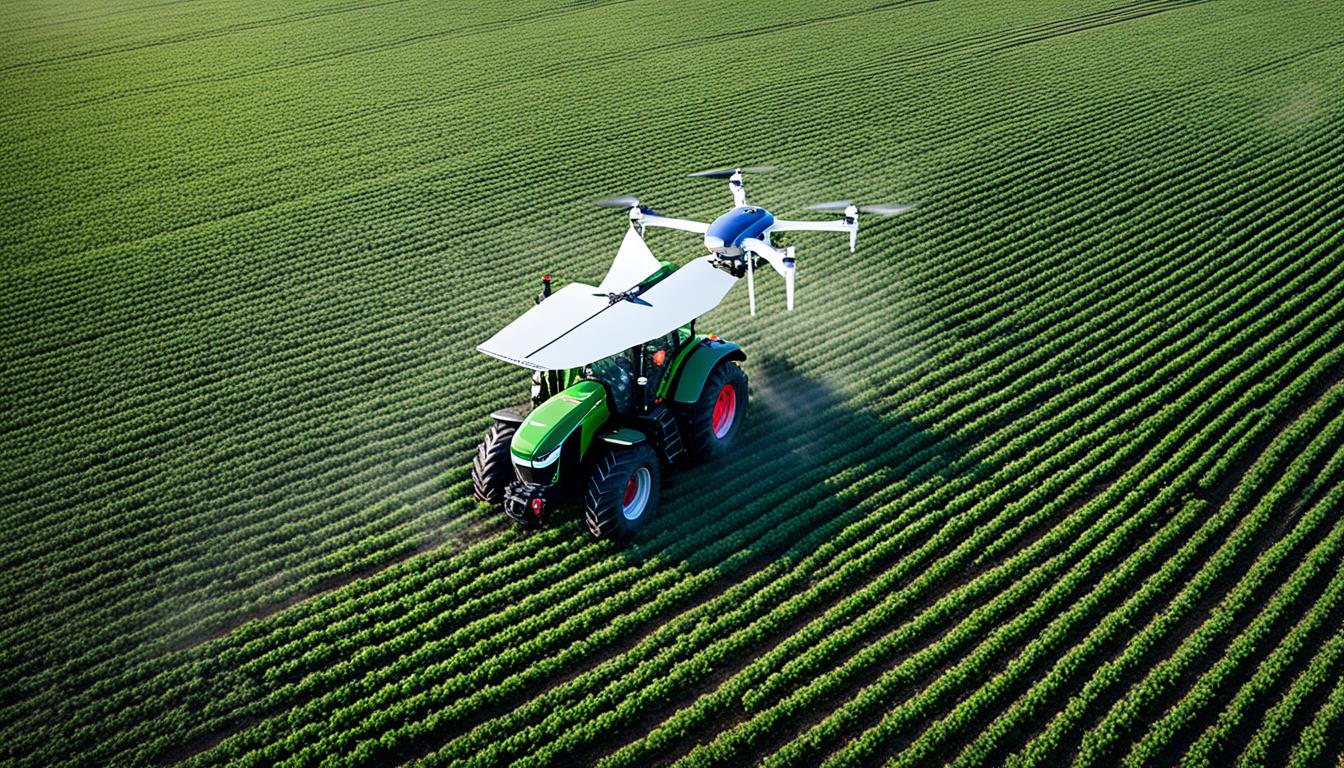
Do you know the global population is likely to hit 10 billion by 2050? This growth means agriculture must find ways to produce more. Traditional farming is changing as we adopt new tech, especially Artificial Intelligence (AI). AI is helping us create a more sustainable food system despite challenges like less land, not enough workers, and climate change.
Intellias and others are at the forefront of using AI in agriculture. They’re creating new ways to check quality and track food. This move from old ways to digital ones is boosting farm profits and improving the food we grow. AI helps by quickly analysing lots of data so farmers can choose better and use resources wisely. This tech is key in making sure we can feed the growing world while taking care of the planet.
Agriculture is changing thanks to AI technology. With the world’s population expected to reach 10 billion by 2050, the need to produce more food is pressing. AI has become key in modern farming, where it helps increase yield.
For years, farming relied on people’s strength and old ways. But, technology has changed everything. Today, farms use AI to deal with challenges like climate change and scarce resources. This shift marks a new era powered by AI, aiming for better productivity and wiser use of resources.
AI in farming means more efficient and precise work. With AI, farming decisions are based on data quickly and accurately. This includes using AI for better irrigation and spotting pests early.
This technology includes smart tools like driverless tractors and agricultural drones. They make farming more efficient and accurate. AI is also used to keep track of cattle health from afar, improving their lives and upping milk production.
AI’s role in farming is growing fast. It helps with things like predicting yields and using pesticides smarter. With the AI in agriculture market set to jump from USD 1.7 billion in 2023 to USD 4.7 billion by 2028, according to MarketsandMarkets, it’s clear AI is here to stay.
AI is leading farming into a new era. It’s shaping a future that’s not just about solving today’s problems but is sustainable and efficient too.
Artificial intelligence (AI) in agriculture uses new tech to boost farming. It uses machine learning to analyse data on crops. This helps farmers improve health, yield, and caring for the environment.
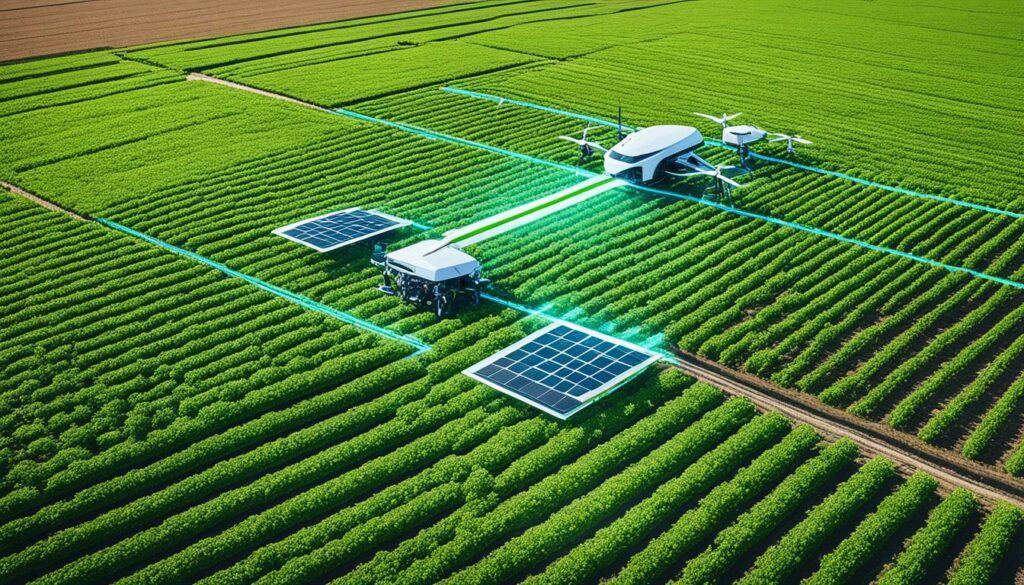
AI in farming means using tech to make farming smarter and more efficient. It includes things like predicting crop growth and using smart devices. With the world’s population growing, AI helps farmers make better decisions to meet our food needs.
AI in agriculture has many benefits which deeply transform farming.
AI also uses data from various sources to better manage farming inputs. This includes information from sensors, satellites, and the weather. With this data, farmers can use fertilisers and water more wisely. This helps create a farming system that is both effective and sustainable.
| AI Application | Primary Benefit | Example |
|---|---|---|
| Predictive Analytics | Market Demand Analysis | Price Forecasting |
| Resource Management | Efficient Use of Water and Fertilizers | Smart Irrigation Systems |
| Pest and Disease Control | Targeted Treatments | AI-Powered Drones |
| Automation | Enhanced Labour Efficiency | Driverless Tractors |
By leveraging AI and advanced analytics, farmers get powerful tools. These tools help solve today’s farming challenges. They also play a key role in ensuring sustainable and abundant food for the future.
The world’s population is rapidly heading towards 10 billion by 2050. This means farming must find new ways to keep up. With the help of AI and data, precision agriculture is changing the game. It allows farmers to use resources efficiently and get the most out of their land.
Data analytics are transforming farming. Farmers are now able to make sense of big data to improve how they grow crops. They can monitor crops closely, manage their farms better, and use resources wisely. This leads to both more productivity and care for the environment.
Yield mapping and predictive analytics are now key in agriculture. They help predict crop yields accurately, which means farmers can make the right adjustments. With AI’s help, these tools boost productivity while reducing waste. This makes farming both greener and more profitable. Also, AI watches over crop and soil health for the best growing conditions.
AI agriculture companies are quickly changing how farming works. They are leading a big change in agribusiness. The world’s population is set to hit 10 billion by 2050. This makes it crucial for farmers to improve their methods to grow more crops. Precision agriculture is making a big difference in this area.
Companies like The Climate Corporation, Blue River Technology, and John Deere are leading the charge. They use AI and smart tools to predict farming needs, analyse soil, and make farming more efficient. This means big improvements for farmers today.
| Company | Key Innovations | Impact |
|---|---|---|
| The Climate Corporation | Predictive Analytics | Improved Yield Forecasting |
| Blue River Technology | Machine Learning-Based Soil Analysis | Enhanced Soil Health Monitoring |
| John Deere | IoT-Driven Precision Farming Tools | Increased Operational Efficiency |
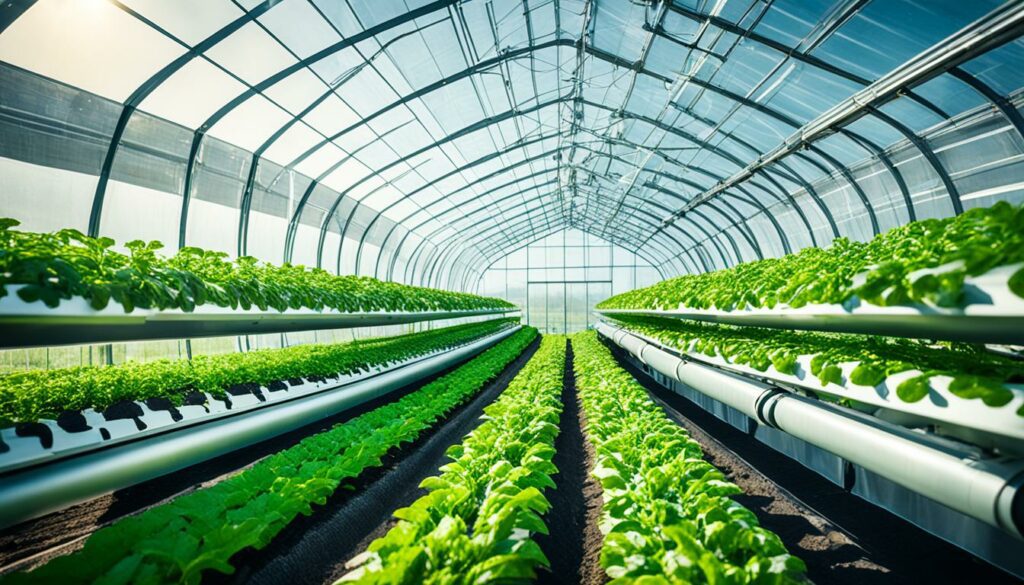
The use of AI in farming is expected to increase a lot. The market will grow from USD 1.7 billion in 2023 to USD 4.7 billion by 2028. It shows that technology and smart farming are key for our future food needs and the planet’s health. For example, AI tools can watch over crops without humans, which cuts costs and mistakes.
AI also helps to farm in a more sustainable way. Smart farms use almost all their resources more efficiently than traditional farms, especially water. This is vital for saving our resources and making sure crops don’t get damaged by pests as much.
Looking forward, working together is essential. Governments, tech firms, and schools need to join forces. They will help solve problems with infrastructure and teach people more about technology. Companies like TYM tractors are building the future of farming with smart features like telematics and automation. They show how AI can make farming stronger against the challenges of our changing climate. It will help make sure there is enough food for us in the future.
AI in agriculture is vital as we approach a 10 billion population by 2050. We need farming that is efficient and eco-friendly now more than ever. AI helps monitor soil and uses weather data to make smarter farming choices. This reduces the harmful effects of farming by managing resources closely.
Finding nutrient shortages in crops can boost yields significantly. AI systems check sensor and satellite data to pinpoint where crops lack nutrients. This information allows farmers to use fertilisers in the right spots, making farming more efficient and healthier for the crops. It’s key for keeping the soil at its best for high yields.
Weather data is incredibly important in farming today. AI can forecast weather conditions well, guiding farmers on when to plant and harvest. It also helps adjust to sudden changes, lowering the risk of crops failing. By understanding and managing farming’s environmental effects with AI, we make agriculture more sustainable for the globe’s future.
The push for AI in agriculture isn’t just about enhancing yields. It’s also aiming to protect our environment. By reducing waste and using resources better, AI is leading a greener, more effective farming.
| AI Application | Benefits |
|---|---|
| Nutrient Deficiency Detection | Improves crop yield and resource efficiency |
| Weather Data Analytics | Enables timely and informed agricultural decisions |
| Environmental Monitoring | Reduces the overall environmental impact of farming |
Smart farming is changing agriculture by using AI in irrigation and vertical farming. These new ways give hope to farming facing more demands but fewer resources. The world’s population is set to hit 10 billion by 2050. So, it’s vital to find new farming solutions.
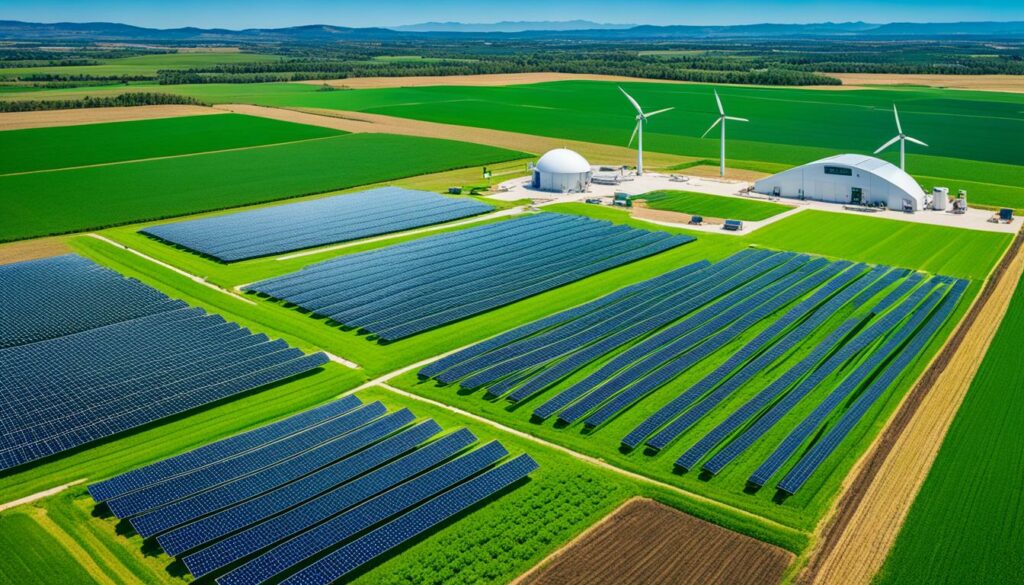
AI in irrigation is crucial for smart farming. It uses data from IoT sensors to manage water better. By checking the soil and weather, AI ensures plants get the right water amount. It also stops water wastage. These systems can even find leaks, protecting crops and saving water.
| Feature | Benefit | Examples |
|---|---|---|
| Real-time Data Monitoring | Optimal Water Usage | Smart Irrigation Systems |
| Anomaly Detection | Leak Prevention | AI-integrated Systems |
| Soil Moisture Sensors | Precision Irrigation | IoT Sensors |
Vertical farming, boosted by AI, is making food production more efficient. It creates ideal growing conditions in small spaces. AI looks after light, moisture, and temperature for plants. This leads to better harvests and the chance to farm in cities or places with little land. It meets the need for sustainable food production worldwide.
The growth of smart farming with AI and vertical farming is a big change for agriculture. The use of AI in farming is expected to jump from $1.7 billion in 2023 to $4.7 billion by 2028. These developments are making farming more sustainable and productive.
By 2050, our world’s population will hit 10 billion. This puts a big demand on agriculture to produce more food. AI is helping in pest and disease detection in farming, bringing new solutions thanks to machine learning. It has boosted how we watch over and keep crops safe.
The use of AI in agriculture is growing fast. It’s predicted to jump from being worth USD 1.7 billion in 2023, to USD 4.7 billion by 2028. This shows how critical AI tech has become in farming.
AI is extremely precise in spotting pests. It can spot insects like flies, bees, and moths with over 90% accuracy. This keeps crops safe from big bug attacks. Startups such as Farmsense use AI sensors to find pests quickly. This not only warns farmers in real time but it also helps in reducing crop damage and using pest control better.
| Dataset | Number of Images | Crop Types |
|---|---|---|
| IPM Images | 3,739 | Tomatoes, Potatoes, Peppers |
| APS Images | 7,000 | Tomatoes, Potatoes, Peppers |
| Plant Doc | 2,598 | Tomatoes, Potatoes, Peppers |
Data like this helps in training AI to identify pests well and takes action quickly. This can cut down the 30-33% of crops we lose to pests each year.
AI is now being used to spot diseases in plants too. It uses machine learning to check lots of plant health images. For example, the PlantVillage dataset has 24 diseases of plant leaves. AI finds these diseases early, which helps crops grow better.
AI drones are also making a big difference. They can put pesticides exactly where they’re needed, which cuts down on harming the environment. A study found that a lot of the world’s farming land is at risk from too much pesticide. It shows that we need AI to protect our crops better.
There are many AI solutions out there now, such as those from CattleEye and Doctor Nabat. They’re improving how we look after plants and animals. This helps more farmers use smart, data-based choices instead of relying heavily on chemicals.
Artificial intelligence and agriculture are coming together to create a bright future. With the global population set to hit 10 billion by 2050, we need smart farming. It’s not just about producing more but also doing it in a way that’s good for the planet.
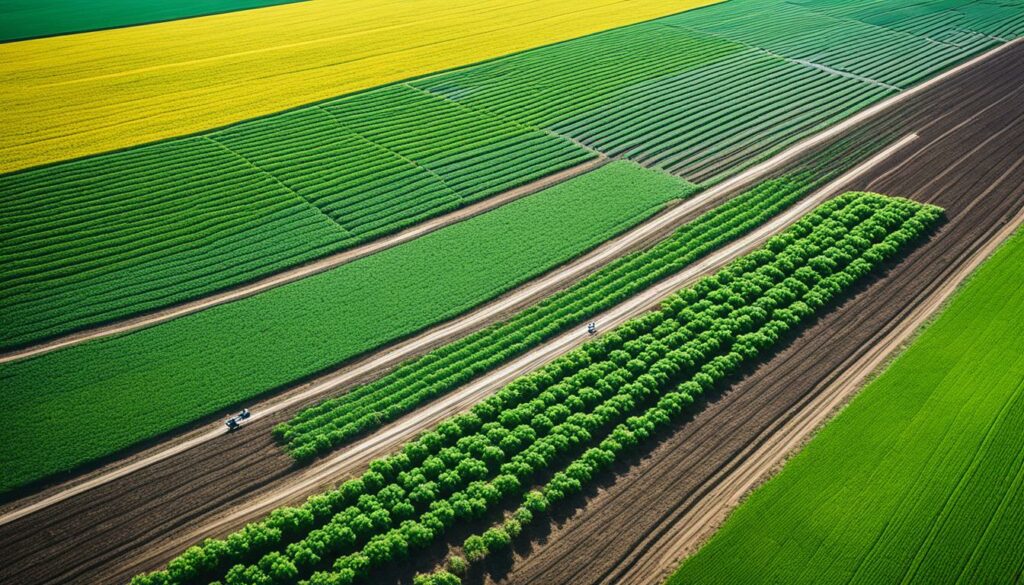
The market for AI in farming is expected to grow a lot, from USD 1.7 billion in 2023 to USD 4.7 billion by 2028. This growth is because AI helps farmers do more with less. It analyses data to improve crop growth using new technologies.
AI brings many benefits. For instance, it can detect apple black rot with over 90% accuracy. The LaserWeeder can get rid of up to 5,000 weeds per minute with 99% accuracy. This reduces costs and makes farming more efficient.
Sustainability is now a big deal in agriculture. Companies like CropX are reducing water use by up to 57%. They also lower fertiliser use by 15%. This helps the planet and makes farming better for everyone.
The future of AI in farming looks exciting. It will change how we farm worldwide. By focusing on using AI for sustainable farming, we can grow more food and take care of our planet better. This is key for food security and protecting the environment by 2050.
| Statistic | Detail |
|---|---|
| Global Population | 10 billion by 2050 |
| AI in Agriculture Market Growth | $1.7 billion (2023) to $4.7 billion (2028) |
| Accuracy in Detecting Crop Diseases | Over 90% (e.g., apple black rot) |
| Reduction in Water Usage (CropX) | 57% |
| Weed Control Accuracy (LaserWeeder) | 99% |
The world of farming is changing fast thanks to machine learning. With the global population predicted to hit 10 billion by 2050, agriculture must find new ways to grow more food. Machine learning tools are key, making farms more efficient and helping our planet.
Machine learning introduces exciting AI in farming that touches many areas. It analyses soil, making sure crops get the right nutrients and grow well. This tech can even watch over crops, spot pests, diseases, and check on animals to help keep them healthy.
It also helps farmers use resources better, for example, managing water and fertiliser smarter. This cuts waste, boosts crop yield, and saves money.
Machine learning’s role in farming will grow. The AI in agriculture market is expected to jump in value. Innovations like driverless tractors, smart irrigation, and drones are on the rise, promising more precise and productive farming.
In the future, these smart systems will get even better at making predictions. They’ll predict weather, spot possible crop failures, and use drones to spray pesticides just where needed. These advances make farming smart and help farmers tackle big challenges.
| Technology | Application | Benefits |
|---|---|---|
| Computer Vision | Monitoring crop growth, pest and disease detection | Precision in interventions, enhanced crop health |
| Predictive Analytics | Anticipating potential issues, resource management | Reduced risk of crop failure, lower costs |
| Autonomous Machines | Driverless tractors, smart irrigation, drones | Efficiency, accuracy, lower human labour dependency |
To sum up, machine learning is transforming agriculture, offering new ways to tackle future challenges. By using AI in farming, we can use resources better, grow more food, and ensure a sustainable future for agriculture.
Agriculture has changed a lot in recent times. It’s moved from hard work by hand to using digital and mechanical technology, thanks to robotics and automation. Now, 70% of the world’s water is used in farming, and 4% of the economy comes from this sector. These systems help solve big challenges like not having enough people to work and making farms more efficient. By 2050, we’ll need to grow much more food to feed a growing population of 9.1 billion. That’s why robots are key in the future of farming.
Robots are making a big difference in farms by helping with hard jobs like gathering and sorting crops. These machines work faster and more accurately than people can. For example, automatic farm vehicles have been around since the 1950s, which do a huge part of the work on modern farms now. They help get crops out on time and sort them well, reducing food waste.
There aren’t enough workers in farming because the world’s population is growing. This means we need more food. Robots are filling in for these missing workers by doing tough jobs, freeing farm workers to do more important work. Systems which use AI to help with farm tasks have been important since the 1980s. Now, they help in many ways, like figuring out the best time to harvest and spotting plant problems early. Robots, for example, can be used to monitor and manage weeds, showing how they can make farming better and more sustainable.
By 2025, the robotic technology market in agriculture is expected to be worth a huge USD 8.82 billion. Also, there will be major investments of $15.3 billion for smart farming by then. This shows that farmers are quickly adopting these new technologies. They help not just with the work but also with making smarter decisions. Together, they aim to help farmers feed an extra 2 billion people by 2050.
AI in farming changes the way we farm using data analysis, learning machines, and IoT. This tech boosts output, saves resources, and makes quick decisions. It includes precise farming and smart techniques.
AI in farming helps predict issues early, boosting crop health and sustainability. It also manages resources smarter and controls pests using advanced methods. Benefits also cover monitoring soil health and predicting market needs.
The Climate Corporation, Blue River Technology, and John Deere lead in using AI in farming. They offer state-of-the-art tools for predicting, analysing soil, and using IoT for farming more precisely.
Precision farming now uses more data, mapping, and predictions. These leaps lead to better crop forecasts, smarter resource use, and better farm management.
AI systems check crops and soil for health, noting any issues early. They use weather data for better decision making, making farm work more efficient and eco-friendly.
AI boosts smart farming with high-tech irrigation and vertical farming. These approaches use sensors and AI for using water and resources well, making food more efficiently.
AI spots pests and diseases by looking at images. This tech makes controlling pests easier and better, leading to healthier crops with fewer chemicals.
AI will grow and change farming with new tech. Its goal is sustainable and very precise farming, aiming to make plants grow well and foresee market needs.
Machine learning studies everything from soil to weather for better farming. It makes farm work smarter and opens new doors for farming’s future.
Robots help when there’s not enough people by making farming more efficient. They help with hard work, especially at busy times like harvests.